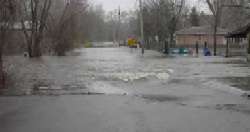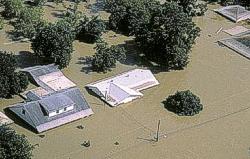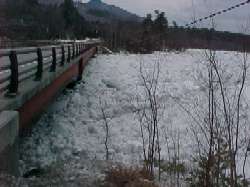|
|
 |
|
|
|
 |
| |
|
|
 |
Weather
More |
River floods
We differ several types of floods:
|
|
|
|
|
 |
River flood
Flooding along rivers is a natural and inevitable part of life. Some floods occur seasonally when winter or spring rains, coupled with melting snows, fill river basins with too much water, too quickly. Torrential rains from decaying hurricanes or tropical systems can also produce river flooding.
Coastal flood
Winds generated from tropical storms and hurricanes or intense offshore low pressure systems can drive ocean water inland and cause significant flooding. Escape routes can be cut off and blocked by high water. Coastal flooding can also be produced by sea waves called tsunamis, sometimes referred to as tidal waves. These waves are produced by earthquakes or volcanic activity.
|
 |
 |
 |
|
1. Mississippi River Flood
source: http://www.umesc.usgs.gov/
flood_2001/surface.html
|
|
Urban flood
As land is converted from fields or woodlands to roads and parking lots, it loses its ability to absorb rainfall. Urbanization increases runoff 2 to 6 times over what would occur on natural terrain. During periods of urban flooding, streets can become swift moving rivers, while basements can become death traps as they fill with water.
|
 |
 |
 |
|
2. Urban flood
source: www.crh.noaa.gov
|
|
Flash flood
see at ’Flash flood’ in this Encyclopedia
Ice jam
Floating ice can accumulate at a natural or man-made obstruction and stop the flow of water.
|
 |
 |
 |
|
3. Ice jams on the Hudson River
source: http://www.erh.noaa.gov/
er/aly/photos/photo.htm
|
|
|
The most common floods are the river floods.
|
The effects of forestry to increase flooding could be quite large. Deforestation causes higher surface runoff, consequential soil erosion and therefore reduced water storage capacity. Landuse and infrastructure are important factors responsible for the increase in peak water levels and frequency of high runoff peaks.
|
 |
 |
 |
|
4. Dike bursting on the river Tisza (Hungary), 2001
|
|
|
Short-term modification of river flood behaviour is agreed to occur due to the human activity associated with forestry such as ploughing and drainage, road construction and compaction of soils. Also, despite the debatable influence of deforestation, tree planting remains a suggested remediation technique of flood effects.
Every alteration in the pattern of agricultural production can be shown to modify flood occurrence and the ploughing up of former extensive grasslands is said to have increased the flood potential of some river basins. Removal of vegetation, or conversion to plants with lower evapotranspiration and interception, increases run-off volumes and lowers storage.
In the future, the actual report of the Intergovermental Panel of Climate Change (IPCC) projects for the 21st century, that because of the more intense precipitation events (which is very likely), the increasing of the flood, landslide, avalanche and mudslide damages are expected.
The recent large floods accelerate the flood modelling experience in Europe. The caused damages are shown in the Table:
|
|
|
 |
5. The summary of losses in Germany
by Jonathan Conway
source: http://www.facworld.com/
FacWorld.nsf/doc/euflood/$file/floodeu2.pdf
|
|
But the ’flood of the century’ was on Elbe in 2002. In parts of the Erzgebirge (mountain range between Germany/Saxony and Czech Republic) more than 300 mm fell in one day. The extreme precipitation was followed by a very quick rise in the water levels of the Elbe tributaries, in particular the rivers, which drain the Erzgebirge to the north. The water level of the Elbe subsequently reached a maximum mark, which had not been recorded for centuries. The total economic damages resulting from the August flood (the Czech Republic: € 3 billion, Austria: € 3 billion; Germany: € 9.2 billion) represent a new European record for flood damages.
|
 |
 |
|
6. The flooding of the Elbe near Elster (left) and the flooded streets of Meissen (right),
photos by M. Zebisch, TU Berlin.
source: http://www.uni-frankfurt.de/~jrapp/centuryflood.pdf
|
Compiled by Sándor Szalai - Hungarian Meteorological Service
Scientific reviewing: Dr. Ildikó Dobi Wantuch / Dr. Elena Kalmár - Hungarian Meteorological Service, Budapest
Last updated 2003-12-15
|
|
 |
|









